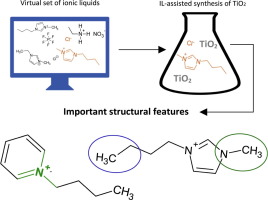当前位置:
X-MOL 学术
›
J. Colloid Interface Sci.
›
论文详情
Our official English website, www.x-mol.net, welcomes your feedback! (Note: you will need to create a separate account there.)
How thermal stability of ionic liquids leads to more efficient TiO2-based nanophotocatalysts: Theoretical and experimental studies.
Journal of Colloid and Interface Science ( IF 9.9 ) Pub Date : 2020-03-25 , DOI: 10.1016/j.jcis.2020.03.079 Anna Rybińska-Fryca 1 , Alicja Mikolajczyk 1 , Justyna Łuczak 2 , Marta Paszkiewicz-Gawron 3 , Monika Paszkiewicz 4 , Adriana Zaleska-Medynska 3 , Tomasz Puzyn 1
Journal of Colloid and Interface Science ( IF 9.9 ) Pub Date : 2020-03-25 , DOI: 10.1016/j.jcis.2020.03.079 Anna Rybińska-Fryca 1 , Alicja Mikolajczyk 1 , Justyna Łuczak 2 , Marta Paszkiewicz-Gawron 3 , Monika Paszkiewicz 4 , Adriana Zaleska-Medynska 3 , Tomasz Puzyn 1
Affiliation

|
Ionic liquids (ILs) containing distinct nitrogen-bearing organic cations (pyridinium, pyrrolidinium, imidazolium, ammonium, morpholinium) were first used for the preparation of 23 IL-TiO2 types of composites by ionic liquid assisted solvothermal synthesis. These 23 optimal ILs structures (i.e. compounds exhibiting an optimal combination of specific properties, functionality, and safety) for synthesis and experimental validation were selected by computational high-throughput screening from a combinatorically created library containing 836 ILs theoretically designed and characterized candidates. Then, selected IL-TiO2 structures with potential photocatalytic activity were synthesized with the use of solvothermal reaction. Then, the decomposition level, the role of the individual IL cation structure on the morphology, thermal stability, surface and photocatalytic properties of the IL-TiO2 microparticles were determined experimentally. The chemoinformatic analysis of the relationship between the structure of the ionic liquid, its thermal stability under the conditions of synthesis and photocatalytic activity was applied for the first time. The results presented here are the first step in the development of methodology (combined experimental and theoretical) that may simplify the procedure of designing safer and more efficient TiO2-based photocatalyst. The developed computational methodology makes it possible to predict properties of newly synthesized IL-TiO2 materials before synthesis and identifies structural features of ILs that influence the efficiency of IL-TiO2 system. The presented approach reduces the number and cost of necessary experiments, as well as increases the success ratio of efficient TiO2-based photocatalyst design by a selection of optimal IL structures (i.e. ionic liquid characterized by a combination of most promising physicochemical features).
中文翻译:

离子液体的热稳定性如何导致更有效的TiO2基纳米光催化剂:理论和实验研究。
包含独特的含氮有机阳离子(吡啶,吡咯烷鎓,咪唑鎓,铵,吗啉鎓)的离子液体(ILs)首先用于通过离子液体辅助溶剂热合成制备23种IL-TiO2类型的复合材料。通过计算的高通量筛选,从包含836个理论上设计和表征的候选IL的组合库中,通过计算高通量筛选,选择了用于合成和实验验证的这23种最佳IL结构(即,表现出特定特性,功能和安全性最佳组合的化合物)。然后,通过溶剂热反应合成了具有潜在光催化活性的IL-TiO2结构。然后是分解水平,各个IL阳离子结构对形态,热稳定性的作用,实验确定了IL-TiO2微粒的表面和光催化性能。首次对离子液体的结构,在合成条件下的热稳定性和光催化活性之间的关系进行了化学信息学分析。本文介绍的结果是方法学(实验和理论相结合)发展的第一步,可以简化设计更安全,更高效的TiO2基光催化剂的过程。先进的计算方法使在合成之前预测新合成的IL-TiO2材料的性能成为可能,并确定了影响IL-TiO2系统效率的IL的结构特征。提出的方法减少了必要实验的数量和成本,
更新日期:2020-03-26
中文翻译:

离子液体的热稳定性如何导致更有效的TiO2基纳米光催化剂:理论和实验研究。
包含独特的含氮有机阳离子(吡啶,吡咯烷鎓,咪唑鎓,铵,吗啉鎓)的离子液体(ILs)首先用于通过离子液体辅助溶剂热合成制备23种IL-TiO2类型的复合材料。通过计算的高通量筛选,从包含836个理论上设计和表征的候选IL的组合库中,通过计算高通量筛选,选择了用于合成和实验验证的这23种最佳IL结构(即,表现出特定特性,功能和安全性最佳组合的化合物)。然后,通过溶剂热反应合成了具有潜在光催化活性的IL-TiO2结构。然后是分解水平,各个IL阳离子结构对形态,热稳定性的作用,实验确定了IL-TiO2微粒的表面和光催化性能。首次对离子液体的结构,在合成条件下的热稳定性和光催化活性之间的关系进行了化学信息学分析。本文介绍的结果是方法学(实验和理论相结合)发展的第一步,可以简化设计更安全,更高效的TiO2基光催化剂的过程。先进的计算方法使在合成之前预测新合成的IL-TiO2材料的性能成为可能,并确定了影响IL-TiO2系统效率的IL的结构特征。提出的方法减少了必要实验的数量和成本,



























 京公网安备 11010802027423号
京公网安备 11010802027423号